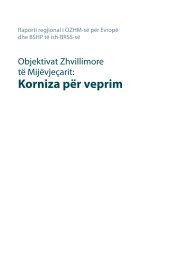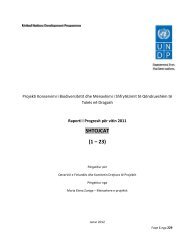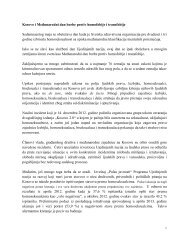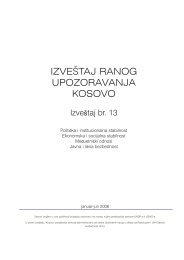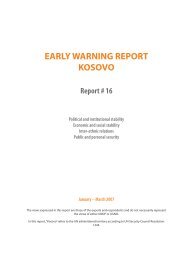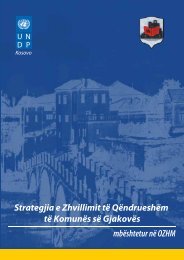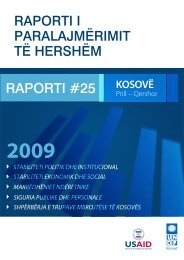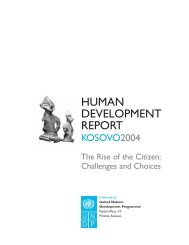Kosovo Human Development Report 2010 - UNDP Kosovo - United ...
Kosovo Human Development Report 2010 - UNDP Kosovo - United ...
Kosovo Human Development Report 2010 - UNDP Kosovo - United ...
You also want an ePaper? Increase the reach of your titles
YUMPU automatically turns print PDFs into web optimized ePapers that Google loves.
FIGURe<br />
0%<br />
2.4<br />
2%<br />
4%<br />
Village<br />
The incidence of exclusion from all factor<br />
markets varies widely across regions.<br />
According to the Mosaic Survey, the<br />
Prizren and Gjilan/Gnjilane regions have<br />
higher incidence of exclusion from factor<br />
markets compared to the <strong>Kosovo</strong><br />
average rate, whereas Gjakova/Djakovica<br />
and Mitrovicë/Mitrovica have the<br />
lowest incidence of exclusion. Furthermore,<br />
while the incidence of exclusion<br />
is lowest in the capital Prishtinë/Priština,<br />
the Prishtinë/Priština region ranks higher<br />
than the overall <strong>Kosovo</strong> rate due to<br />
surrounding municipalities.<br />
In Dragash/Dragaš and Malishevë/<br />
Malisevo (both in the Prizren region)<br />
there is a higher incidence of exclusion<br />
from factor markets, at 22.5 percent<br />
and 15.5 percent of households<br />
excluded from all factor markets<br />
respectively, while Viti/Vitina (in the<br />
Gjilan/Gnjilane region) has a higher incidence<br />
of exclusion from factor markets,<br />
at 18.6 percent. Prishtinë/Priština<br />
region, Fushë Kosovë/<strong>Kosovo</strong> Polje<br />
42 | KOSOVO HUMAN DEVELOPMENT REPORT <strong>2010</strong><br />
and Lipjan/Lipljane rank higher with<br />
16.5 percent and 13.6 percent respectively.<br />
Education: as expected, exclusion<br />
rates from all factor markets<br />
were lower for individuals with high<br />
levels of education. The more educated<br />
had lower incidence of exclusion<br />
from factor markets because of<br />
their better employment prospects<br />
and access to the labour market (see<br />
Figure 2.6 below)<br />
Ethnicity: <strong>Kosovo</strong>-RAE communities<br />
have the highest exclusion rates from factor<br />
markets with 40.6 percent excluded<br />
from all factor markets. <strong>Kosovo</strong>-Albanian<br />
exclusion is similar to the <strong>Kosovo</strong> average<br />
at 8.1, while <strong>Kosovo</strong>-Turks and<br />
<strong>Kosovo</strong>-Bosnians face an exclusion<br />
rate of 5.4 percent. The lowest incidence<br />
of exclusion is among <strong>Kosovo</strong>-<br />
Serbs, at 3 percent. <strong>Kosovo</strong>-RAE households<br />
experience a higher rate of unemployment<br />
than the <strong>Kosovo</strong> average<br />
(58 percent versus 45 percent), with<br />
Percentage of households exluded from all factor markets across various settlement sites<br />
6%<br />
8%<br />
10%<br />
6.5%<br />
Source: Calculated from <strong>Kosovo</strong> Mosaic Survey, <strong>UNDP</strong> 2009<br />
8.7% 2.7%<br />
City/Town Prishtinë/Priština <strong>Kosovo</strong><br />
7.6%



